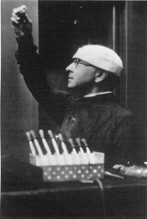Growing Mammalian Cells and Tissues in Culture

Changing fluid in tissue-culture flask in Carrel's laboratory. Courtesy of the Rockefeller Archive Center
In the first decades of the 20th century, Alexis Carrel (1873-1944) and members of his laboratory at the Rockefeller Hospital pioneered methods of tissue culture—of growing cells and tissues in glass dishes. In fact, Carrel coined the term. Today, with disposable glassware, stock media, and standardized methods, tissue culture is seen as a routine technique. But in the 1920s and 1930s, working out the nutritional requirements of cells and devising means to avoid bacterial infection of cultures were major challenges. Carrel's group sought to solve these problems in order to study cell metabolism and the function of whole organs outside the body.
Among the researchers in Carrel's laboratory, Lillian E. Baker (1890- death date) made important contributions to developing the media for growing fibroblasts, epithelial cells, and monocytes, among other cells and tissues. At a time when thyroid function was not well understood, she also studied both human and animal thyroid tissue, which was kept alive in an apparatus developed in the lab that perfused it with blood-like medium. She had developed the perfusion fluid, which included hormones and vitamins in addition to salts, proteins, and carbohydrates. In one study, human thyroid tissue was kept alive and in good condition for three weeks, a necessary precursor to further investigation. In another experiment, with cat and rabbit thyroids, Baker discovered that the gland secretes iodine in two forms.

Carrel, Alexis
Courtesy of the Rockefeller Archive Center

Baker, Lillian
Courtesy of the Rockefeller Archive Center
Lillian E. Baker received the AB from Wellesley College (1914) and the PhD from Columbia University (1922). From 1914 to 1918 she was an instructor in physics and chemistry at the Pratt Institute. In 1922 she joined the Rockefeller Hospital. She remained at Rockefeller her entire career, and was publishing research as late as 1954.
Alexis Carrel was born and educated in Lyons, France, and he received his medical degree from the University of Lyons (1900). In 1904 he took a research position at the University of Chicago, and in 1906 he joined the Rockefeller Institute. Carrel was awarded the Nobel Prize in 1912 for developing the first surgical techniques to stitch together blood vessels. He remained at Rockefeller until 1939, when he returned to France.
Selected Publications
Carrel A and Baker LE. The chemical nature of substances required for cell multiplication. J Exp Med, 1926, 44: 503-521
http://www.jem.org/cgi/reprint/44/4/503
Baker LE. The chemical nature of the substances required for cell
multiplication: II. Action of glutathione, hemoglobin, and ash of liver
on the growth of fibroblasts. J Exp Med, 1929, 49: 163-182
http://www.jem.org/cgi/reprint/49/2/163
Baker LE. Artificial media for the cultivation of fibroblasts, epithelial cells and monocytes. Science, 1936, 83: 605-606
Baker LE. The secretion of iodine by thyroid glands cultivated in the Lindbergh pump. Science, 1938, 88: 479-480
Baker LE and Ebeling AH. Artificial maintenance media for cell and
organ cultivation: I. The cultivation of fibroblasts in artificial and
serumless media. J Exp Med, 1939, 69: 365-378
http://www.jem.org/cgi/reprint/69/3/365
Baker LE and Carrel A. Artificial maintenance media for cell and organ
cultivation: II. The cultivation of organs in artificial media. J Exp
Med, 1939, 70: 29-38
http://www.jem.org/cgi/reprint/70/1/29
Foot NC, Baker LE, and Carrel A. The behavior of abnormal human thyroid
tissue cultivated in the Lindbergh apparatus. J Exp Med, 1939, 70: 39-52
http://www.jem.org/cgi/reprint/70/1/39
Links
Rockefeller Archive Center, Papers of Alexis Carrel
http://www.rockarch.org/collections/individuals/ru/
